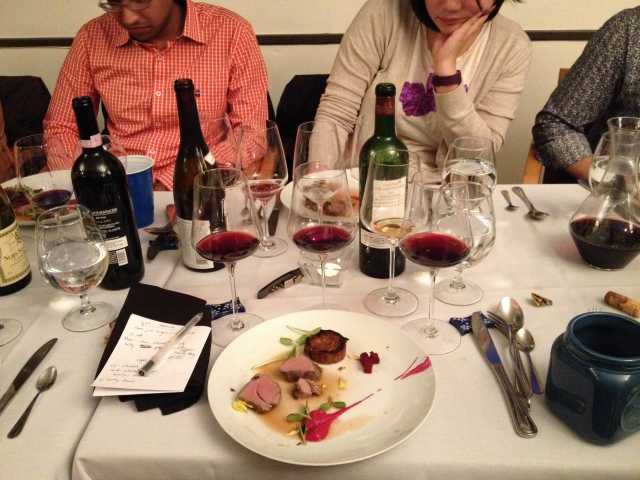This is a great theme for a tasting… 2001 vintage in any region. Other people should have similar tastings with their own tasting group!
WINEBERSERKERS OFFLINE - 2001 TASTING - The Palace, Mission, SF (7/1/2015)
Whites
Both excellent examples of their relevant styles. Both superb wines, but my personal preference is always for off-dry German rieslings. The 2001 Prum was excellent, though perhaps still too young.
-
2001 Trimbach Riesling Cuvée Frédéric Emile - France, Alsace
Golden-orange color; wonderful nose with caramel apricot cake; completely dry, rich, balanced acid, some secondary and tertiary complexity. Nice overall. 91 (91 pts.) -
2001 Joh. Jos. Prüm Wehlener Sonnenuhr Riesling Auslese - Germany, Mosel Saar Ruwer
Light yellow-golden color; distinct nose of petrol, pear, limestone; palate has richness, great acidity, balanced sweetness, lemon-lime, very fresh, great balance; long finish. 93-95 (94 pts.)
Pinot
Initially I had a preference for the dramatically complex nose of the Jadot, but over time that nose moderated significantly and the Dehlinger became more complex and spicy. By the end of the night, I preferred the Dehlinger.
-
2001 Louis Jadot Nuits St. Georges 1er Cru Les Boudots Domaine Gagey - France, Burgundy, Côte de Nuits, Nuits St. Georges 1er Cru
Pale ruby; aromatic nose with combination of red fruit, black fruit, spice, intoxicating; palate is light bodied but dense chewy black fruit, superb acidity throughout, almost youthful, well integrated light tannin; medium finish. Excellent burgundy at early maturity. 93-95.
After an hour, much more reticent on the nose. I don’t know what happened… maybe it was just overshadowed by the bigger bodied wines that followed. 91 (92 pts.) -
2001 Dehlinger Pinot Noir Octagon Vineyard - USA, California, Sonoma County, Russian River Valley
Deep black fruit, spicy, intense ripe balanced fruit; medium bodied, ripe, classic Californian fruit, lots of spice; short-medium finish. Very nice and ready to drink, classically made but ripe sunny Californian fruit. 91
With time, lots of complexity on the nose and palate with spice. Significant improvement with air, and eventually beat out the Jadot premier cru. 92 (92 pts.)
Italian vs. Rhone
I had a strong preference for the Hermitage, which got progressively better as the night went on and had great freshness and synergy with the food. Not heavy at all. Not close to the level of a Chave (what is…), but other than that very solid.
-
2001 Pertimali (Livio Sassetti) Brunello di Montalcino Riserva - Italy, Tuscany, Montalcino, Brunello di Montalcino
A little reticent on the nose with some mild spice and minerality; palate has excellent acidity, cherry fruit, light tannin; short-medium finish. Nothing too remarkable, but nice. Maybe young? 87-88 (88 pts.) -
2001 Paul Jaboulet Aîné Hermitage La Chapelle - France, Rhône, Northern Rhône, Hermitage
Deep ruby color; nose has moderate intensity, meaty, minerality, flinty, bloody heme minerality, black fruit; palate is medium bodied, very good acid that keeps things incredibly fresh, light on the fruit; medium finish. Well balanced, very fresh, good body and texture as well as meatiness, but it lacks the fruit or additional complexity that I was expecting. 90-91
A little green asparagus after some air. Lots of complexity now. I think this just needed some time to blossom. Superb wine. 92-93+. (93 pts.)
Bordeaux
This was my favorite, though it was far, far too young. Needs at least 5-10 more years, but it had the great combination of density, freshness, balance, elegance, and potential for future growth. Well made bordeaux in a riper but classic style (balanced without being rustic).
-
2001 Château Cos d’Estournel - France, Bordeaux, Médoc, St. Estèphe
Deep ruby-purple color with no bricking; deep full nose with blackberry, black currant, graphite, lead pencil, youthful; palate is full bodied, youthful tannins, black fruit, great balanced acidity; medium-long finish. Superb, very youthful. Hold for 5-10 years and drink over the next 2-3 decades. 93-96. 94
With time, this blossoms and starts showing a lot of red fruit. Wonderful. 95+ (95 pts.)
Sauternes
Always one of my favorite parts of the evening. The Nairac was excellent and got better as it got more and more air. It’s never going to be the best 2001 Sauternes, but it holds its own and is extraordinarily enjoyable with almost any type of food. I think this is one to drink in the medium term, ie. over the next decade. I don’t think it will be a 40-50 year wine like the Suduiraut, Rieussec, etc.
-
2001 Château Nairac - France, Bordeaux, Sauternais, Barsac
From a 750. Deeper golden-orange color than expected compared to other 2001s; nose has good intensity, citrus orange marmalade, swirling brings out gobs of botrytis spice, slight minerals but really quite a dense nose; palate is full bodied, rich but not dense, quite sweet but with just enough acidity to feel fresh if not overly vibrant, orange, slight caramel, fruit fades by the midpalate as it transitions towards a short finish. This is enjoyable, feels ready to drink now, balanced acid, good either by itself or with food, but it lacks the complexity of the best 2001s. 90-91
Update 20 min: yes, it’s not the most complex, but I find myself coming back to the glass. Just very enjoyable, and it never seems to heavy even though it’s a richer youthful style. Delicious now, but I’m not sure whether this will be an excellent tertiary Sauternes once the fruit disappears.
Update: 4 hours later: Opened up even more with time. Very nice, wonderful balance. More saffron spice. A step up from when first opened. 91-92 (92 pts.)
Posted from CellarTracker
